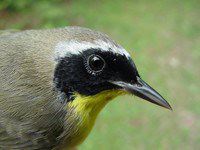|
|
|||
While working at our computer this week at Hilton Pond Center, we glanced at a Flowering Dogwood tree just outside the window. This particular tree plays host to a variety of fauna throughout the year; in the past month or so its trunk or branches have been graced by--among others--a Virginia Opossum, Black Ratsnake, Carolina Anole, and Eastern Gray Squirrel, miscellaneous insects, and an assortment of spring migrant warblers. On 3 May, we added to the "tree list" a trio of Rose-breasted Grosbeaks, Pheucticus ludovicianus. 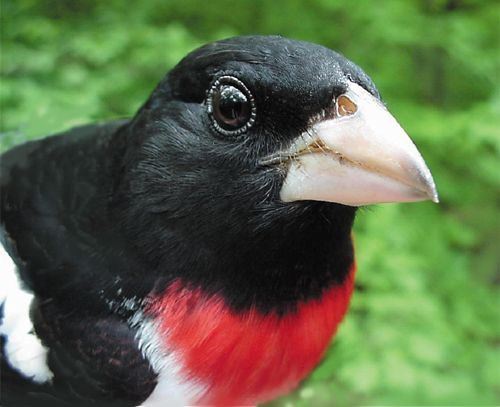 All text & photos © Hilton Pond Center As we plunked away on the computer that afternoon, a male grosbeak (above) landed on a low branch only five feet away and just sat there, casting his eyes toward a nearby sunflower seed feeder. A few moments later, another male arrived and sparred briefly before moving to a different limb. Both birds were close enough so we could see individual feathers on the wings and tail,
All text & photos © Hilton Pond Center Old female Rose-breasted Grosbeaks sometimes have a pale buffy wash on the breast, but they lack any of the brightness of the male--unless you peer beneath the bird's wings. The underwing coverts of a male Rose-breasted Grosbeak mirror those of his chest (below left), while those of a female are pale yellowish or salmon-colored (below right). In autumn, sexing Rose-breasted Grosbeaks in a tree becomes more difficult because young males hatched that year look like females; in flight (or in the hand), their underwing linings are that tell-tale rose color (bottom photo).
All text & photos © Hilton Pond Center The three birds that perched outside our window at Hilton Pond Center eventually disappeared around the corner of the house and within a few minutes had entered a sunflower seed trap. As we extricated them, they squawked loudly enough to draw in another male and female grosbeak that scoped out the scene and departed for parts unknown. We banded the captured birds with care since the Rose-breasted Grosbeak's bite is far worse than its bark--a distinctive metallic "peek" that carries well in the woods. Rose-breasted Grosbeaks occur at the Center only during migration. Each spring they pass through in early May on their way to breeding grounds in southern Canada and the northcentral and northeastern states; some nest down the Appalachians and even in smaller numbers in the Carolina mountains. Grosbeaks return to the Piedmont from mid-September to mid-October, this time while winging their way toward wintering areas in the West Indies and Mexico, and south to Peru. Over the past two weeks the Center has received a dozen or so calls and e-mails from across the Carolinas asking whether there are unusually high numbers of Rose-breasted Grosbeaks in 2002, or whether it's possible that any of the female birds could actually be Black Grosbeaks. The latter species does occur very rarely in the Carolinas, and the females do superficially resemble Rose-breasted Grosbeaks. However, a female Black Grosbeak typically has very fine streaking on its flanks, a mostly unstreaked breast that is yellowish rather than white, a darker face, and bright yellow wing linings. The Center's banding totals imply that 2002 is indeed a good year for Rose-breasted Grosbeaks in the Carolina Piedmont. Counting this year's birds, we've only banded 26 grosbeaks since 1982--13 each in spring and fall migration--and never more than four in a calendar year. Those three that we banded this week--plus two that didn't enter the trap--meant we had five at one time at Hilton Pond Center. Perhaps recent heavy thunderstorms in the central U.S. pushed these birds eastward, and maybe subsequent rain in the Northeast caused the grosbeaks to stack up in the Carolinas. By some standards, we don't really have a "glut of grosbeaks," but it was still great to be able to see five of them all at once as they migrated through the Carolina Piedmont.
If you enjoy "This Week at Hilton Pond," please help Support Hilton Pond Center for Piedmont Natural History. It's painless, and YOU can make a difference! You may wish to consult our Index of all nature topics covered since February 2000. For a free, non-fattening, on-line subscription to "This Week at Hilton Pond," just send an e-mail with "Subscribe" in the subject line to THIS WEEK |

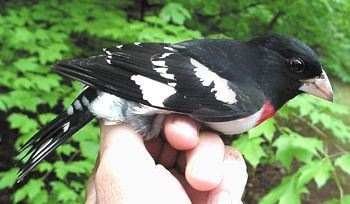 and both sported the spectacular rose-colored chest patch that gives the species the first part of its name; as expected, they also bore the enormous pinkish bill that gives rise to the term "grosbeak." Equally visible on each bird in the dogwood were its jet-black head, back, and bib, and a large white shoulder patch and wing bar that contrasted with the dark wings. There also were white spots on the otherwise black tail and rump.
and both sported the spectacular rose-colored chest patch that gives the species the first part of its name; as expected, they also bore the enormous pinkish bill that gives rise to the term "grosbeak." Equally visible on each bird in the dogwood were its jet-black head, back, and bib, and a large white shoulder patch and wing bar that contrasted with the dark wings. There also were white spots on the otherwise black tail and rump.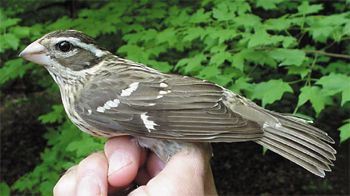 Shortly after the male grosbeaks arrived, they were joined by a same-sized brown bird that looked very, very different; a glance at its massive mandibles confirmed that a female was now part of the grosbeak party. The female Rose-breasted Grosbeak (above right) is mostly drab brown on her dorsal parts, with white wingbars, white streaking on the back, a white breast with heavy brown streaking, and a prominent white eyeline. These field marks are quite similar to those of a female Purple Finch, but the grosbeak is nearly twice the finch's size.
Shortly after the male grosbeaks arrived, they were joined by a same-sized brown bird that looked very, very different; a glance at its massive mandibles confirmed that a female was now part of the grosbeak party. The female Rose-breasted Grosbeak (above right) is mostly drab brown on her dorsal parts, with white wingbars, white streaking on the back, a white breast with heavy brown streaking, and a prominent white eyeline. These field marks are quite similar to those of a female Purple Finch, but the grosbeak is nearly twice the finch's size. 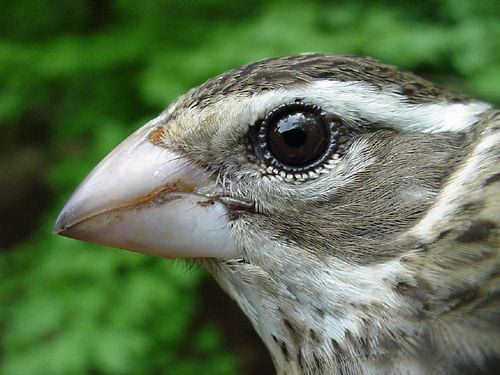
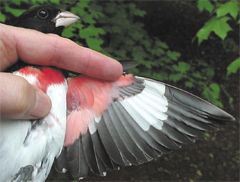 .
.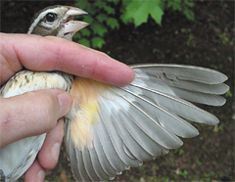
 Although their heavy bills are nicely adapted for opening stout seeds and nuts, Rose-breasted Grosbeaks also consume large numbers of insects--including beetles, caterpillars, and scale insects that otherwise might dine on agricultural crops.
Although their heavy bills are nicely adapted for opening stout seeds and nuts, Rose-breasted Grosbeaks also consume large numbers of insects--including beetles, caterpillars, and scale insects that otherwise might dine on agricultural crops.
